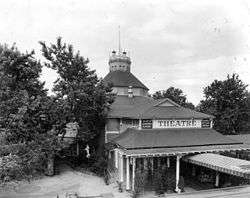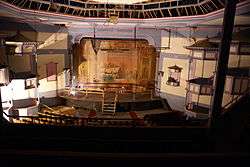Elitch Theatre
|
Elitch Theatre | |
 | |
  | |
| Location | W. 38th Ave. and Tennyson St., Denver, Colorado |
|---|---|
| Coordinates | 39°46′6″N 105°2′46″W / 39.76833°N 105.04611°WCoordinates: 39°46′6″N 105°2′46″W / 39.76833°N 105.04611°W |
| Area | Highlands |
| Built | 1890 |
| Architect | Lee & Liden |
| Architectural style | Stick/Eastlake, Shingle Style |
| NRHP Reference # | 78000844[1] |
| CSRHP # | 5DV.143 |
| Added to NRHP | March 21, 1978 |

The Historic Elitch Theatre is located at the original Elitch Gardens site in northwest Denver, Colorado. Opened in 1890, it was centerpiece of the park that was the first zoo west of Chicago. The theatre was Denver's first professional theatre, serving as home to America's first and oldest summer-stock theatre company from 1893 until the 1960s. The first films in the western United States were shown there in 1896. Cecil B. DeMille would send yearly telegrams wishing the theatre another successful season, calling it "one of the cradles of American drama."
The theatre closed in 1991 and exterior restoration on the historic auditorium was completed in 2007. Fundraising continues for interior renovations before opening to the public. The vision is to reopen as a year-round multimedia performing arts complex for the community offering education, film, live music, and theatre.
History
John Elitch and Mary Elitch Long first opened Elitch Gardens on May 1, 1890, with animals, bands, flowers and an open-air theatre where Mayor Londoner of Denver spoke.[2] Inspired by Shakespeare's Globe Theatre, the first shows were vaudeville acts by accomplished local and national performers. In 1891 the theatre was enclosed and rebuilt for $100,000. The Boston Opera Company performed musicals, and light opera starting with The Pirates of Penzance. In 1893 the first summer stock theatre company, the Norcross Company, was organized in the East and brought to the gardens. Vaudeville shows continued until 1900.
In 1896, Edison's Vitascope was exhibited at the theatre showing the first films in Colorado.[3]
The Elitch Gardens Stock Theatre Company began performing in 1897 under the management of Mary Elitch Long. Its first season in 1897 opened with leading man James O'Neill, who had promised John that he would act in the new theatre when it was ready. The first show performed there was Helene.[4] The company became known for putting on ten plays in a ten-week summer season and attracting internationally known stars of the theatre and screen.
Sarah Bernhardt came to Denver in 1906 after the San Francisco earthquake destroyed the California Theatre where she was scheduled to perform. At Elitch's she played Camille at the matinée and LaSorcier at night. Douglas Fairbanks was hired into the same company. Prior in 1905, he was hired to sweep the stage for theatre tickets.
The costs of running the park became too much for Mary Elitch and with the purchase of Elitch Gardens by John Mulvihill in 1916, she stepped down from control of the Gardens and theatre. However, two lower theatre boxes were always reserved for her and her friends. Mulvihill oversaw the theatre until his death in 1930[5] and was succeeded by his son-in-law Arnold Gurtler.[4]
In 1953, the Elitch Theatre was used for two days to film scenes for The Glenn Miller Story.[6]
The Elitch Garden Theatre Company became its own incorporated business, separate from the Elitch Gardens Park, renting the theatre in 1963. The company stopped operating as a traditional resident summer-stock switching to single, star-packaged shows out of New York. The company had many successful years but as time and culture changed the theatre building was neglected.
The park's Trocadero Ballroom was torn down in 1975. Fearing a similar fate, the community was able to add the theatre to the National Register of Historic Places in 1976.
The Elitch Theatre Company's last season was in 1987. The park booked the "Incredible Acrobats of China" for a season,[7] then one night musical acts before it was officially closed in 1991. The Robber Bridegroom was performed with Patrick Cassidy for the theatre's centennial anniversary.[8] Actor Raymond Burr raised $2 million for an educational program at the theatre. The money was instead donated to local Cole Middle School.
The Elitch Gardens amusement park moved to the current central Platte Valley location in 1994. The new $94 million park was opened in 1995 with attendance reaching one million. Two fires in 1995 on the old Gardens property near the theatre cause public outcry for additional security.[9] The original Elitch property was sold to Perry Rose LLC in 1996 with the conditions that the theatre and carousel shell never be demolished.[4][10]
A nonprofit organization, the Historic Elitch Gardens Theatre Foundation, was formed in 2002 to raise funds, maintain, preserve and restore the Elitch Gardens Theatre and carousel pavilion.[11] In 2006, groundbreaking for the renovation of the theatre began with restoring the building's exterior, including a cement foundation for the building.[12][13]
As of 2010, the exterior restoration of the building is complete but the interior remains unrestored. [14] In 2011, Barbara Medill, a friend of Mary Elitch Long's, donated some of Long's possessions to the Foundation, including an engraved silver place setting.[15] After a massive volunteer cleanup, the interior was opened for Doors Open Denver in April 2012.[16] Musicians and Shakespearean performers were the first acts on stage in the 22 years since the building closed.
Restoration

In 2006, the Historic Elitch Gardens Theatre Foundation was awarded $5 million in federal, state, city, grants and private donations. Work began on saving and restoring the historic exterior. A cement foundation was poured under the exterior walls, replacing beams resting on large stones on the bare ground. The roof, gable, main entrance/lobby, and the exterior walls were all replaced and painted.
In 2011, the beautifully hand-painted decorative historic "Anne Hathaway" curtain, (oil on canvas: circa early 1900's), was taken down and stored, after it had been discovered with water damage and tears in the fabric: (the curtain was rolled up and stored in a backstage room at the theatre.) In addition to the damaged curtain, there was extensive erosion to certain areas of the theatre from years of neglect and un-use. Generations of pigeons, fox and other small critters living inside the theatre were evicted in 2011 and brave volunteers cleaned up their feces and other excrement.
2012: Roof repaired in the fly building to fix huge leaks over the stage. Unfortunately, the repairs were not suitable, and the roof still has leaks in a few places. Toddler swimming pools (complete with "rubber duckies") have replaced buckets in the back stage area—someone's creatively comical way of taking care of problematic symptoms of the greater threat: water damage.
2013/2014: A fire suppression sprinkler system was installed, and restoration work for code compliance and safety issues was instituted.
2016: "Curtains Without Borders" (a non-profit organization formed to help restore and teach proper storage etiquette of antiquated theatre curtains and drapes.) Representatives from the group were called upon to give a lecture at the Elitch Theatre about theatre grand drapes and curtains. They were asked to review the Elitch Theatre's "Anne Hathaway" grand drape and give advice on its restoration. The drape was taken out of storage that day and unrolled by CWB representatives and faithful theatre volunteers who discovered that it had been stored improperly; water had damaged the drape to the point of being illegible, and the paint had dissolved into clouds of dust as the curtain was unrolled. The curtain was displayed on the backstage theatre floor for lecture attendees to view; those who regarded it as a piece of Colorado history were devastated by the fact that it had been destroyed by time and neglect.
Interior historic restoration work is still needed. Currently without plumbing or air conditioning, the building needs modernization while preserving the original woodwork and design. Fundraising continues by the Historic Elitch Theatre Foundation to reach those goals.
Stars Who Appeared at The Elitch Theatre

- Steve Allen, 1974
- Morey Amsterdam, 1968
- Eve Arden, 1965
- Cliff Arquette, 1966
- George Arliss, 1905–06, '13
- John Astin, 1973–74
- Sarah Bernhardt, 1906
- Beulah Bondi, 1925–26
- Shirley Booth, 1968
- Helen Bonfils, 1934–59
- Raymond Burr, 1944
- Sid Caesar, 1971, '74
- Kitty Carlisle, 1965, '70
- Cecil B. DeMille, 1905
- Brandon deWilde, 1972, died in motor vehicle accident before leaving town.
- Patty Duke, 1973–74
- Douglas Fairbanks, 1905
- Douglas Fairbanks Jr., 1971–73
- Maude Fealy, 1896, 1903, 1904, 1907, 1909, 1917
- Jose Ferrer, 1973
- Minnie Maddern Fiske 1905, 1907–08
- Arlene Francis, 1964–65, '69
- Mitzi Gaynor, 1987
- Barbara Bel Geddes, 1964
- George Gobel, 1971
- Karen Grassle, 1972
- Julie Harris, 1978
- Mimi Hines, 1965, 1968, 1970
- Kim Hunter, 1975
- Gabe Kaplan, 1982–83
- Grace Kelly, 1951
- Cloris Leachman, 1982–83
- Harold Lloyd, 1914
- Myrna Loy, 1969
- Fredric March, 1926–28
- Enid Markey, 1942
- Jayne Meadows, 1974
- Patricia Neal, 1947
- Maureen O'Sullivan, 1972, '82-83
- Walter Pidgeon, 1964
- Antoinette Perry, 1904–05
- Howard Platt, 1968, 1984
- Jane Powell, 1981
- Tyrone Power, 1905
- Vincent Price, 1979
- Rosemary Prinz, 1968, 1977
- John Raitt, 1977, '79
- Robert Redford, 1955
- Lynn Redgrave, 1975
- Debbie Reynolds 1986
- Edward G. Robinson, 1922
- Ginger Rogers, 1975
- Cesar Romero, 1964
- Mickey Rooney, 1972–74
- William Shatner, 1975, 1980
- Haila Stoddard, 1953, 1975, 1983
- Gloria Swanson, 1967
- Constance Towers, 1969
- Ernest Truex, 1903, 1904, 1906
- Lana Turner, 1977
- Joan Van Ark, 1960
- Dick Van Patten, 1968
- Helen Ware, 1912
- Nancy Walker, 1987
- Blanche Walsh, 1901
- David Warfield, 1908
- Paxton Whitehead, 1979
- Shelley Winters, 1973, '83
- Donald Woods (actor), 1933-32, 1939, 1941, 1947–48
- Jane Wyatt, 1939
- Stephen Stills, 1991
References
- ↑ National Park Service (2008-04-15). "National Register Information System". National Register of Historic Places. National Park Service.
- ↑ "Elitch Gardens Opens: Crowds Brave Rain". Rocky Mountain News. 2 May 1890.
- ↑ "Edison Invention At Elitch's". Rocky Mountain News. 16 August 1896.
- 1 2 3 Moore, John (16 April 2006). "Famous, soon-to-be-famous crossed Elitch stage". Denver Post.
- ↑ "John M. Mulvihill, Theatre Man, Dead; Succumbs in Denver to Illness Dating From His New York Visit". New York Times. 15 January 1930. p. 25.
- ↑ Otte, Jef (6 June 2012). "Radium and roller coasters: A brief, dirty history of Elitch Gardens". Westword. Retrieved 3 August 2012.
- ↑ "Acrobats of China bring an incredible act to Elitch's". The Gazette. Colorado Springs, Colorado. 15 July 1988.
- ↑ Rosen, Steven (15 June 1991). "'Bridegroom' opens Elitch's 100th year". Denver Post. p. 1D.
- ↑ Robinson, Marilyn (4 November 1995). "Fire spurs call to up security Old Elitch park scene of blaze". Denver Post. p. B1.
- ↑ Sinisi, J. Sebastian (29 August 1995). "Landmark status urged for Elitch Theatre". Denver Post. p. B3.
- ↑ "Elitch Theatre announces restoration plan". Denver Business Journal. 17 April 2006.
- ↑ Chandler, Mary Voelz (15 August 2006). "Cleaning up its act; Elitch Theatre restoration raises money and spirits". Rocky Mountain News.
- ↑ Moore, Paula (30 March 2008). "Restoration of Elitch theatre needs at least $5M more". Denver Business Journal. Retrieved 3 August 2012.
- ↑ Frazier, Donald (October 2010). "Beyond the Lighted Stage". 5280.
- ↑ Jefferson, Elena Ashanti (19 February 2011). "Friend of Mary Elitch helping with theatre's restoration effort". Denver Post.
- ↑ Painter, Kristen Leigh (16 April 2012). "Denver opens doors to unique buildings, landmarks". Denver Post. Retrieved 3 August 2012.
External links
- Historic Elitch Garden Theatre Foundation
- Elitch Gardens Official Site
- A Word on the Elitch Theatre featurette
- Historic Elitch Gardens Theatre 2010 Video
- Elitch's Comeback Performance, 2012 story on Colorado Public Radio